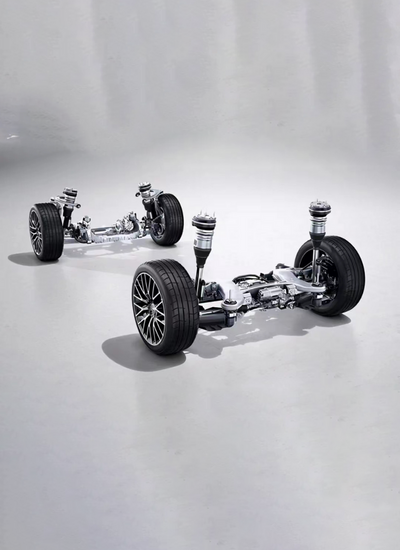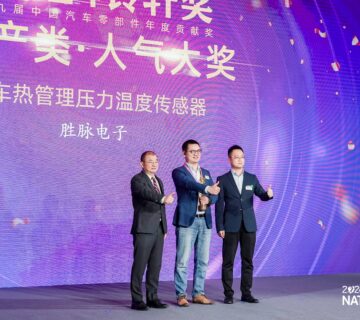The car suspension system refers to the entire support system composed of springs and dampers between the body and tires, which is the connection device between the body and wheels, transmitting the force and moment acting between the wheels and the frame, and cushioning the impact force transmitted to the frame or body by the uneven road surface, attenuating the vibration caused by it, and ensuring the smoothness of the car driving. The suspension system integrates a variety of forces, and the wheels form the car driving system, and the transmission system, steering system, braking system together as the four systems of the car chassis, is one of the key parts of the car.
The two most important parameters that determine the suspension system are stiffness and damping. Stiffness is a measure of the ability of the suspension to resist deformation, equal to the ratio of the load applied to the suspension and the deformation of the suspension caused by the load, while damping is the resistance of the spring movement at the opposite speed, only negative work, consuming excess energy of the suspension to attenuate vibration. Among them, the stiffness characteristics are mainly provided by the springs, while the damping characteristics are mainly provided by the dampers. Traditional passive suspension uses hydraulic dampers and coil springs in the form of structure, making the suspension structure once determined its own stiffness and damping coefficient can not be changed. In the process of vehicle driving, the body will inevitably be subject to various frequency bands of excitation, when the excitation frequency is close to the body’s inherent frequency, the body will appear violent vibration, to the vehicle’s driving safety brings great hidden danger, but also will greatly weaken the passenger ride comfort. In order to improve the vibration damping performance of the vehicle, the car companies based on new materials and technologies developed a variety of damping elements and elastic elements. Now generally based on whether there is energy input to the vehicle suspension passive suspension, active suspension and semi-active suspension.
Air suspension is an important direction for the intelligent upgrading of automotive chassis
Air suspension uses an air pump to form compressed air and send the compressed air to the chamber of the air spring, which changes the spring stiffness by changing the air density, thus changing the vehicle height. According to the output signal of the height sensor, the suspension control unit determines the change of body height and then controls the air pump and air distribution valve to make the spring compress or extend. The height of the air suspension is adjustable and the suspension stiffness is adjustable, so the driving experience is much better than that of steel spring suspension.
Air suspension system mainly consists of air supply unit, air spring, damper and control unit.
(1) Air supply unit: consists of air pump, air dryer, air storage tank, etc. The air supply assembly is generally placed in the engine compartment or trunk.
(2) air spring: air spring is a non-metallic spring that uses the compressibility of air to achieve elasticity by adding compressed air in a flexible sealed container. It has excellent elastic properties, thus improving the comfort of the vehicle’s operation. And it can be selected by changing the air pressure regardless of the vehicle load. For example, the stiffness can be reduced by adding additional air chambers to increase their internal volume.
Depending on the container used for compressed air, the air spring has two forms: capsule and membrane, and the capsule air spring is composed of a rubber air bag with a cord and the compressed air enclosed in it. The inner layer of the air bag is made of gas-tight rubber, while the outer layer is made of oil-resistant rubber. A steel belt ring is enclosed between the section and the section so that the middle part does not have radial expansion and prevents the two sections from rubbing against each other. In contrast, the airtight capsule of a membrane gas spring consists of a rubber diaphragm and a metal part, which will produce radial expansion.
(3) Damper: Generally speaking, the height of the body is adjusted by the air spring, while the “softness” is left to the independent damper. The damper mainly plays the role of cushioning the impact of the road. The spring is to change the “large energy impact” into “small energy multiple impact”, while the damper is to gradually reduce the “small energy multiple impact”.
At present, the main dampers can be divided into ordinary hydraulic dampers and electromagnetic dampers. The ordinary damper can not be actively adjusted, only according to the factory settings to provide damping characteristics. The electromagnetic damper is divided into solenoid valve damper and magnetorheological damper two mainstream technical routes, including solenoid valve damper, by the damper inside the solenoid valve to control the internal fluid flow, so as to achieve damping, that is, the “soft and hard” active control. The magnetorheological damper, however, replaces the normal oil inside the damper with a magnetic suspension of soft particles. When the liquid is injected into the electromagnetic coil inside the damper piston, the magnetic field of the coil will change its rheological characteristics (or produce fluid resistance), thus producing a rapid response and controllable damping force without an electromechanical control valve and a simple mechanical device, thus actively adjusting the “soft and hard”.
(4) control unit ECU: including height control valve (so that the air spring under load are maintained at a certain height), electronic control suspension system (dynamic adjustment of suspension stiffness and height), etc. ECU is actually a miniature electronic computer, after obtaining information from various sensors, after comparing, calculating, and then send command signals to each component according to the designed working mode. On different road surfaces, the ECU collects external information such as body height uploaded by sensors in time to process and react.
Improved Driving Comfort Perceptible to Consumers
The suspension of traditional cars is generally composed of traditional steel springs and ordinary dampers, which passively carry out force cushioning and rebound force abatement. The suspension stiffness and damping coefficient can not be adjusted according to the actual road conditions, which in principle limits the passive suspension damping performance, but due to its simple design, low cost, reliability, and other advantages, the passive suspension is still widely used in low-end cars and trucks. The air suspension can actively control the height of the body, body tilt and damping coefficient, etc. Compared with traditional suspension, air suspension can adjust the chassis height, damper damping, etc. according to the different working conditions of the car. Air suspension is also more stable in maintaining the horizontal height of the vehicle, and the horizontal state of the body can be maintained all the time, which is affected by the vehicle load and improves the comfort of driving for users.
(1) Air chamber significantly reduces noise and enhances the vehicle’s premium feeling
As the electric vehicle eliminates the engine, the tire noise and road noise originally covered by the engine noise are exposed after the engine noise is eliminated. Unlike the solid connection structure of traditional steel springs, air springs use air chambers, which can isolate most of the noise transmitted upward from the ground during driving, significantly improving the vehicle’s sense of premium, and can be equipped with advanced audio, increasing the vehicle’s sense of quality and premium.
(2) High-speed chassis downward pressure, improve high-speed control stability
When the vehicle reaches high speed, the ECU of the electronically controlled suspension chassis automatically determines that it is in high-speed driving condition, actively lowering the height of the vehicle chassis, reducing the wind resistance coefficient and the center of gravity of the vehicle, increasing the air spring stiffness and damping stiffness, improving the vehicle’s feedback ability to the road, and greatly improving the acceleration ability of the vehicle and the stability of the vehicle’s high-speed handling.
(3) Air springs provide lateral support at bends
When the vehicle passes through the steering and road sensors, the chassis ECU recognizes that the vehicle is in a curved driving state, and will adjust the stiffness of the four air springs and the damping coefficient of the shock absorber independently in real time within milliseconds according to the curved condition to improve the lateral support of the vehicle when cornering. The effect of air suspension is even more significant when the vehicle is driving in a sharp and continuous curve.
(4) Correction of “starting head lift”, improve the level of acceleration at the start
General vehicle in the acceleration of the start, because of the force factor of the rear sinking, the suspension of the softer vehicles are prone to the phenomenon of a larger head lift, at this time will weaken the front wheel grip, resulting in light sound, but the start is half a beat slower, resulting in the start of the acceleration can not reach the highest level. Equipped with air suspension can automatically identify the vehicle in the starting state, adjust the different suspension softness and support, correct the phenomenon of head lift, increase the wheel grip, improve the starting acceleration and handling level.
(5) Correction of “braking nod”, reducing the discomfort of emergency braking
When the vehicle is braking, the speed of inhibition will compress the front overhang, resulting in the nodding of the head down. Usually, focus on handling performance cars and sports cars because the suspension tuning is stiff, so the nodding amplitude is relatively small, thus reducing the reaction time of emergency braking, shortening the braking distance, which is conducive to continuous vehicle handling changes and improve the handling. At the same time, the nodding phenomenon brought about by emergency braking can also bring strong discomfort to passengers, bringing dizziness and nausea. Fully automatic air suspension in through the acceleration sensor, can react and adjust the suspension stiffness and damping effect at the millisecond level, in the braking time, can improve the stiffness in an instant, the suspension becomes more rigid, greatly reducing the nodding amplitude, with the performance car direction close, improve the whole car in the braking control level reduced.
(6) Quickly control the wheel jump, reduce the sense of bumpy vehicles on rough roads
When the vehicle is over speed bumps or rough suburban roads, the fine bumpy road surface will directly feedback to the suspension system, when the vehicle suspension is hard, it will bring a strong sense of bumps, causing discomfort to the user. Therefore, usually the ride comfort of performance cars is relatively poor, but models with soft suspension will filter the road well. Through fast wheel hop control, adjusting spring travel and rigidity while reducing damping, the wheels will show small hop control, but the overall body posture undulation is particularly small, and the vehicle can pass speed bumps and rugged roads steadily and quickly, reducing the sense of bumps and greatly improving the comfort of the rider.
The value of air suspension is further highlighted in the era of electrification and intelligence
Air suspension is a good fit for new energy vehicles, specifically in terms of.
(1) Protecting the battery
At present, the power battery is placed on the chassis of the car, and the air suspension can actively adjust the height of the vehicle to protect the battery module so that it will not be damaged because the body is too low or through roadblocks. When driving on bumpy roads, it can improve the passability of the vehicle by lifting the body to avoid bottoming out.
(2) More safety and lower energy consumption
The new energy vehicle body is heavy and the chassis is more difficult to control, while the air suspension system can effectively improve the stability of the vehicle and the smoothness of driving. At the same time, when the vehicle is driving at high speed, it can reduce the resistance of the vehicle driving at high speed by lowering the body, and significantly reduce energy consumption.
Air suspension intelligence is reflected in the linkage with driving assistance functions and intelligent cockpit, mainly through the input of data from different sensors into the decision chip, so as to realize the linkage with cross-functional modules.
(1) Automotive intelligence can give full play to the value of air suspension
Through the intelligent system to identify the road conditions, predict the suspension travel; additional sensors (camera, radar, etc.) to detect the working conditions in advance, control the shock absorber and change the working mode.
(2)Personalized setting
The vehicle can record the user’s customary suspension settings and upload them to the cloud. Thereafter, no matter the user changes any vehicle of the same model, it can make the unfamiliar vehicle quickly set to the user’s most familiar state.
Localization of air suspension system to reduce cost
With the trend of automotive electronics and intelligence, the electronic control characteristics of air suspension are a must. At present, the industry manufacturers, and institutions are in the general direction of the future evolution of consensus – “distributed”, “domain centralized”, and “central computing”. The automotive industry as a whole stands in the period of electronic and electrical architecture from distributed to domain centralized, leading car companies have been thinking about a variety of solutions for cross-domain integration, while the traditional mechanical parts are being controlled by electronic control elements (ECU) unified is now popular, and the whole industry is evolving to a domain controller (DCU), the demand for electronic control is even stronger. Compared with the traditional steel suspension is not adjustable, air suspension stiffness damping can be adjusted and controlled by ECU, which more in line with the trend of industry development. With the development of autonomous driving technology, air suspension is being combined with the vehicle sensing system, which can be achieved by combining with cameras, LIDAR, and other front vision, automatically sensing roadblocks and puddles encountered during the driving process, and automatically lifting and lowering the body through algorithms.
Air suspension market domestic replacement space is large
Air suspension uses air as the power source for chassis adjustment, and the high-pressure gas sealing of the relevant components is required to be high. In addition, the air suspension system for sensors, ECU, and actuator parts requires high requirements and needs to be properly connected to each other, so that the equipment to correctly record and execute the signal from all sensors, and the electronic control system requires high precision. From the perspective of the production process, due to the complex structure of the air suspension system, the development team needs to have a rich interdisciplinary and multi-disciplinary knowledge reserve of vehicle dynamic mechanics, automotive electronics, etc., which puts forward higher requirements on integration capability and production process. We believe that the core difficulty of air suspension system development mainly lies in the independent research and development of air springs and other core components and electronic control systems, and independent production capacity. At present, the field is still in the oligopoly of overseas giants, domestic suppliers are expected to achieve a breakthrough based on cost advantages, key processes, and algorithms, and research and development advantages.
Air suspension market space is expected to expand tenfold in the next five years. According to estimates, the current domestic air suspension market penetration rate of about 1%, looking ahead to 2025, the air suspension penetration rate is expected to exceed 10% (including new energy vehicles air suspension penetration rate of 30%, traditional fuel vehicles air suspension penetration rate of 1%), the industry space has ten times the growth space. Specifically, with the current air suspension system (hardware + software) value of about 10,000 yuan, it is expected that by 2025, with the expansion of the industrial scale, the cost of air suspension system is expected to fall to about 8,000 yuan. Consumer upgrading demand with cost reduction, together to promote the air suspension penetration rate, the future is expected to become 200,000-400,000 price range of fuel cars + electric vehicles mainstream optional configuration, and new energy vehicles penetration rate is higher:
(1) new energy vehicles are not cost-sensitive;
(2) air suspension is the key to differentiated competition, configuration “arms race”
(3) the weight of new energy vehicles, high battery protection requirements, air suspension can significantly improve the comfort, battery safety; is expected that by 2025, the passenger car air suspension market size of 23.3 billion yuan, commercial vehicle air suspension market size of 4.5 billion yuan, the total domestic air suspension market space of about 27.8 billion yuan.





No comment